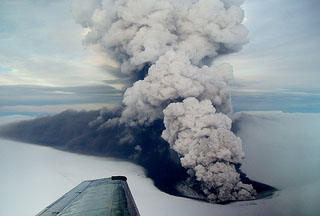Report on Grimsvotn (Iceland) — 12 October-18 October 2022
Smithsonian Institution / US Geological Survey
Weekly Volcanic Activity Report, 12 October-18 October 2022
Managing Editor: Sally Sennert.
Please cite this report as:
Global Volcanism Program, 2022. Report on Grimsvotn (Iceland) (Sennert, S, ed.). Weekly Volcanic Activity Report, 12 October-18 October 2022. Smithsonian Institution and US Geological Survey.
Grimsvotn
Iceland
64.416°N, 17.316°W; summit elev. 1719 m
All times are local (unless otherwise noted)
Icelandic Meteorological Office (IMO) reported that the small jökulhlaup at Grímsvötn that began on 10 October had peaked on 16 October and then began to subside. The onset of the jökulhlaup was slower than forecasted, flowing in the Gigjukvisl River at about 300 cubic meters per second by 12 October. The ice sheet had subsided a total of 7 m. A M 2 earthquake was recorded on 13 October just NE of Grímsvötn but did not signal increased seismicity. By 14 October the outflow from the lakes was an estimated 500 cubic meters per second and subsidence has totaled 15 m. Four earthquakes, all under M 2.5, were recorded during 15-16 October. The Aviation Color Code remained at Yellow (the second lowest level on a four-color scale).
Geological Summary. Grímsvötn, Iceland's most frequently active volcano in recent history, lies largely beneath the vast Vatnajökull icecap. The caldera lake is covered by a 200-m-thick ice shelf, and only the southern rim of the 6 x 8 km caldera is exposed. The geothermal area in the caldera causes frequent jökulhlaups (glacier outburst floods) when melting raises the water level high enough to lift its ice dam. Long NE-SW-trending fissure systems extend from the central volcano. The most prominent of these is the noted Laki (Skaftar) fissure, which extends to the SW and produced the world's largest known historical lava flow in 1783. The 15 km3 basaltic Laki lavas were erupted over 7 months from a 27-km-long fissure system. Extensive crop damage and livestock losses caused a severe famine that resulted in the loss of one-fifth of the population of Iceland.
Sources: Icelandic Meteorological Office (IMO), Institute of Earth Sciences

